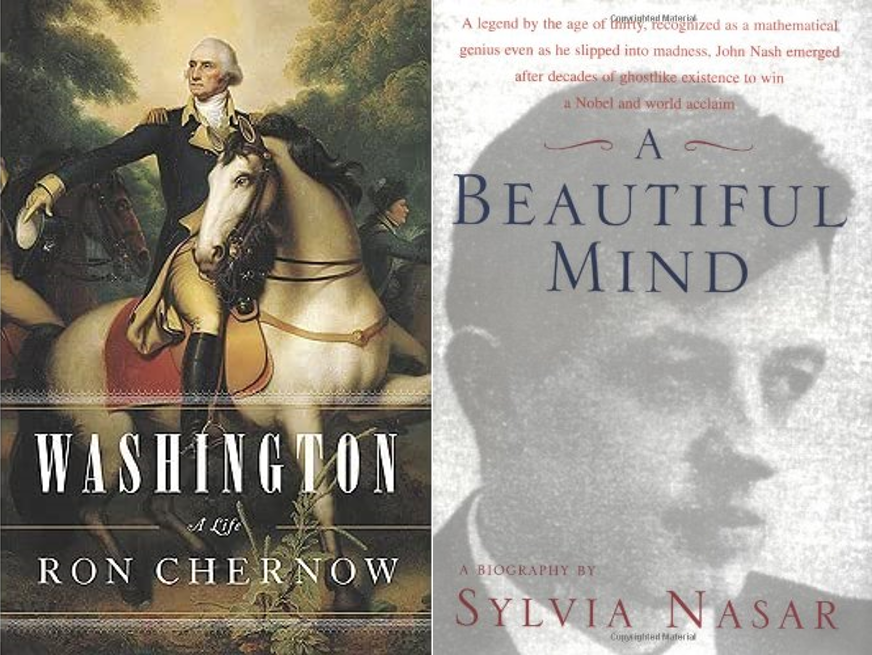Guides • Perfecting your Craft
Last updated on Oct 15, 2025
Nonfiction: 24 Genres and Types of Fact-Based Books
Martin Cavannagh
Head of Content at Reedsy, Martin has spent over eight years helping writers turn their ambitions into reality. As a voice in the indie publishing space, he has written for a number of outlets and spoken at conferences, including the 2024 Writers Summit at the London Book Fair.
View profile →Many readers think of nonfiction as a genre in itself. But take a look through your local bookstore and you’ll see dozens of sections devoted to fact-based books, while fiction titles are sorted into just a few broadly defined genres like ‘Fantasy/Sci-Fi’ and ‘General Fiction’!
To give nonfiction books the recognition they deserve and help authors choose the right category for their work, here’s a list of the 24 most common genres of nonfiction along with their identifying features.
Expository nonfiction
Expository nonfiction aims to inform the reader about its subject — providing an explanation for it, be it a historical event, natural phenomenon, fashion trend, or anything else.
1. History
History books are not to be mistaken with textbooks. Rather than cherry-picking details to be memorized about a person, an event, or an era, these nonfiction titles are more like cross-sections in time. They provide readers with as much of the social and political contexts of events as possible with the use of rich primary and secondary sources, so as to better understand their causes and their legacies.
📚 Examples
Guns, Germs, and Steel by Jared Diamond
Tapping into geological, agricultural, and biological evidence, Diamond challenges perception of genetic differences and contextualizes the history of human development using various external, environmental conditions.
Leningrad: The Epic Siege of World War II, 1941-1944 by Anna Reid
The Eastern Front of WWII is not as well-discussed as the Western one, though it's just as important. To balance the viewpoints out a little, Anna Reid explores life in Leningrad (now St Petersburg) during one of the longest, costliest, and deadliest military blockades in history.
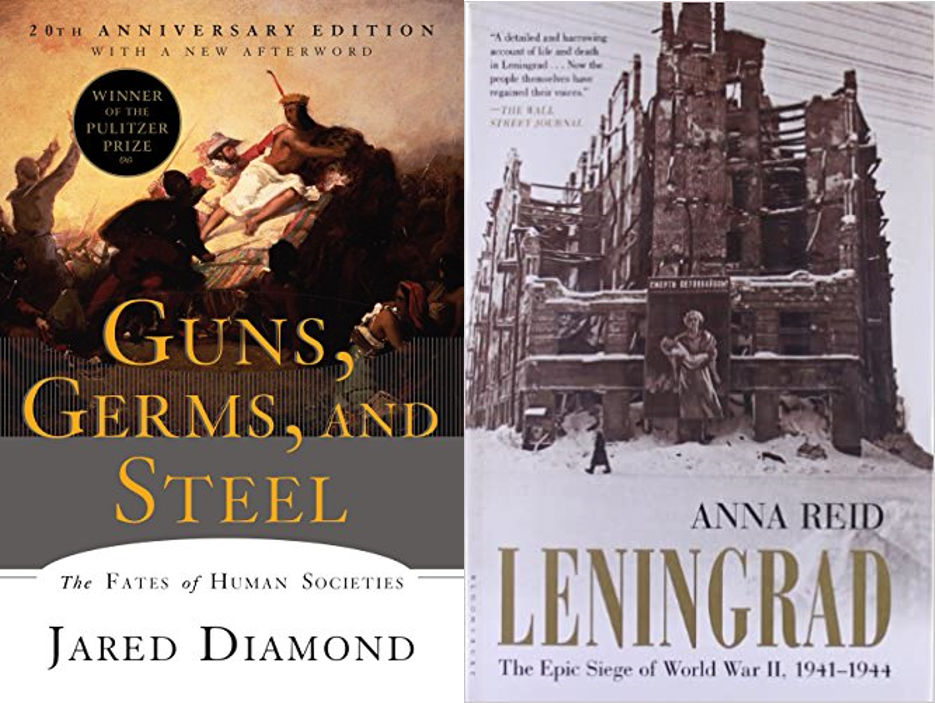
2. Philosophy
This is where the big questions get asked. While ‘philosophy’ conjures up the image of impenetrable books written by Nietzche and Confucius for the enjoyment of beard-stroking academics, that isn’t the be-all-and-end-all of this genre! Contemporary authors have taken care to make their writings more accessible without sacrificing depth of analysis.
Q: How do you maintain an author's voice while editing nonfiction?
Suggested answer
I never put my own stamp on an author's work! I generally highlight areas where I'd like an author to expand so that they are providing the new writing themselves.
Rennie is available to hire on Reedsy ⏺
If you're an editor with enough experience, this comes naturally. The most important thing is to realize that the work needs to reflect the individual and his/her/their connection to the subject matter. You edit only to clarify, correct, etc.--not to express your own personal opinions about the subject matter, or to make their voice like your own. Editors in any case are there in service to the work and to writers to accomplish what they want for that work. Honesty is always important--but a writer's voice is as unique as a fingerprint. Changing that is not our job.
K.j. is available to hire on Reedsy ⏺
Since I have already given the author a sample edit, they’ve been able to assess whether I understand their intention and “hear” their voice clearly. Some authors have honed their voice over years and multiple projects while others are still working theirs out. I get a sense of this to begin with, and clarify with them what they are hoping to achieve with the editing I provide. Sometimes I will read an author’s other work or we may have a video call to discuss what they need. Once I have the full manuscript I read it thoroughly, “listening” to it, getting familiar with it. My task is not only to honor their unique voice, but to help bring it forward clearly, somewhat like a microphone or sound system is designed to bring a singer’s voice forward so the audience can hear it clearly. My goal is to understand the author’s intention and partner with them to achieve that goal. I can reflect back to them whether they are being consistent, or how a particular style may come across—is it having the effect they want or is a certain technique only distracting? I make notes or ask questions in the margins and the author can respond there so our conversation stays connected to the area of the book we are discussing. I find this collaborative approach to be the most effective way to maintain and empower the author’s voice and intention.
Clelia is available to hire on Reedsy ⏺
There’s a saying—“You can be an editor or you can have friends.” First off, do the basic scope out: Two spaces after every sentence? Consistently? But mostly clean writing with subject-verb agreement? Copyediting magic involves polishing and appreciation of the amazing work of writing a book. Be competent and respectful and pick your editorial battles—this is someone’s baby! Defer to the author if they fight you on CMOS if it reads clean. (Well, sometimes you have to show them the citation, but it’s up to them at the end of the collaboration). Be kind! Make your author proud!
Deirdre is available to hire on Reedsy ⏺
This is an important topic. It's important to spend a bit of time reading the manuscript to understand the writer's voice. For example, I recently completed editing a literary memoir that used no semi-colons or em dashes. I didn't pick up on this at first, and for the first few chapters, I was adding semi-colons to address traditional comma splices. Soon I realized that there wasn't a single semi-colon in the manuscript except for the few that I had added, and that their authority significantly disrupted the loose, open flow of the writer's voice. Sentence fragments and comma splices were, in fact, central to the writer's literary style. I added this rule to the style sheet and ensured it was consistent throughout, making suggested edits only when something was unclear or the style was losing its effective and becoming repetitive. The takeaway is that style sheets can be an effective way of preserving a writer's style and voice if the rules within them are thoughtfully made and relational to each project.
Holly is available to hire on Reedsy ⏺
📚 Examples
Think: A Compelling Introduction to Philosophy by Simon Blackburn
An introduction to life’s grandest topics (ethics, freedom, self — all that jazz) as told through the prism of history’s greatest philosophers. Suitable for curious readers who don’t know their Aristotles from their Kants.
How to Think Like a Roman Emperor by Donald Robertson
The author smuggles in a history of the great philosopher king by presenting it as a self-help guide. By showing his readers how Marcus Aurelius’s beliefs can apply to modern life, Robertson appeals to readers who wouldn’t otherwise pick up a copy of Meditations from the library.
A Grammar of the Multitude by Paolo Virno
See how philosophy has evolved in today’s international world through Paolo Virno's perspective. He advocates for the understanding of people as "multitudes" (courtesy of Dutch Enlightenment thinker, Spinoza). It's recommended that readers go into this book with some previous knowledge on classic philosophical paradigms.
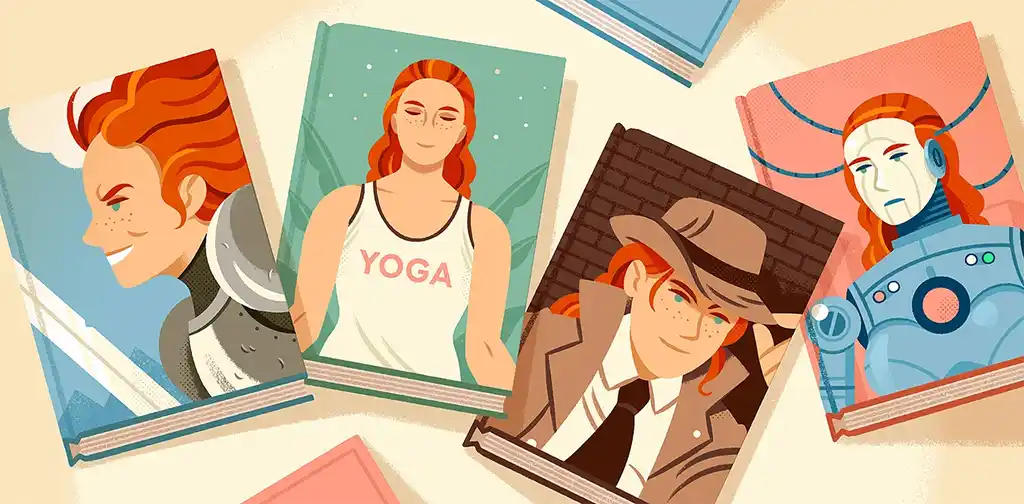
FREE RESOURCE
Book Proposal Template
Craft a professional pitch for your nonfiction book with our handy template.
3. Religion and Spirituality
Books about religion and spirituality can take many forms. Some are theory-based, some are written from personal experience, and some are structured like a self-help book, with the end goal of helping readers find their spiritual home. Oftentimes, each book focuses on a particular belief system — there are even Christian publishers who are solely dedicated to publishing books about their religion.
📚 Examples
Waking the Buddha by Clark Strand
An interesting cross between a historical research and a personal spiritual exploration, this book details the rise and continued influence of the Soka Gakkai, an international Buddhist organization that works towards egalitarianism and social justice.
The Power of Now by Ekchert Tolle
This self-help-style book brings readers closer to spiritual enlightenment by acknowledging how our mind focuses on the past and the future rather than the present. It's the first step on the path toward mindful connection with the joys of the moment.
Expert nonfiction editors, at your
Lois S.
Available to hire
Editor of nonfiction books for over 30 years. Publishers have consistently trusted me with their most challenging projects.
Michael M.
Available to hire
Editor of award-winning literature and NYT bestsellers, with 13 years' experience at Penguin Random House, Macmillan, and Hachette.
Angela Yuriko S.
Available to hire
Publishing coach, multi Bram Stoker Awards® Winner+, publisher of Space and Time and Authortunities, a calendar of author opportunities.
4. Science
Science books, or “Science & Maths” books — as Amazon would categorize them — can get quite technical. Most of the time, they’re reporting on scientists’ academic research. And so, science books tend to be well-organized and follow academic conventions like referencing and indexing. But while they sound dry, the intriguing questions that they address can always be presented in ways that keep readers coming. In any case, readers can always choose to scan over the complex mathematical proofs, or authors can put all that into the appendix.
📚 Examples
A Brief History of Time by Stephen Hawking
See the concept of time through the logical and characteristically witty eyes of this world-renowned scientist. It doesn’t make for the breeziest read, but it will give readers a very in-depth understanding of this arbitrary but ever-present concept.
Origins: Fourteen Billion Years of Cosmic Evolution by Neil deGrasse Tyson and Donald Goldsmith
Neil deGrasse Tyson takes readers on a tour of the universe's transformations through the years, introducing concepts of moons’ orbits and expanding stars along they way. All of this is a sturdy stepping stone to the complex realm of cosmology.
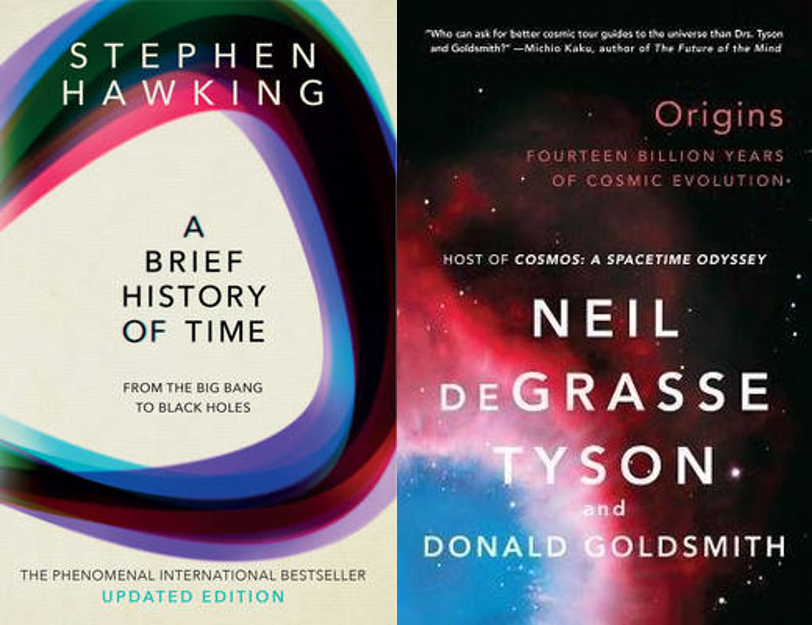
5. Popular Science
Is this type of nonfiction just academic science books but repackaged for laypeople? Why yes indeed. Popular science books take complex research and processes and get rid of most of the jargon, so that your average Joe can pick them up and learn something new about our universe. They’re almost like Vox videos, but that you read instead of watch.
Q: What types of nonfiction authors are likely to succeed without an agent, and why?
Suggested answer
If you are a celebrity or significant political figure and are really going to only write one book, you are probably better off having a lawyer who bills by the hour than an agent to whom you have to pay 10-15%. Examples of people who used a lawyer instead of an agent include President Bill Clinton, Nikki Haley, Karl Rove, Janet Yellin among others.
Tom is available to hire on Reedsy ⏺
If you have a large platform (like a big social media following, an influential organization, or an active speaking career), take a look at the world of hybrid publishing. Hybrid publishing allows you to bypass the agents and editors in the traditional publishing world, and gives you more control over your finished product.
Hybrid publishing can be expensive. It's worth the investment if the book is a tool in your tool belt, and a way to build more authority in a field in which you're already well-known. If you are confident that your platform can drive sales without a dedicated publisher marketing team, it can be a great option!
Kate is available to hire on Reedsy ⏺
📚 Examples
A Short History of Nearly Everything by Bill Bryson
Bill Bryson isn’t a scientist or an anthropologist, but he’s brought together knowledge from various disciplines to create this digestible, comprehensive exploration of the universe and the human race.
Astrophysics for People in a Hurry by Neil deGrasse Tyson
Tyson’s expertise as a science communicator shines through with this armchair-expert version of astrophysics, which he claims can be read on noisy buses and trains without much headache.
6. Politics and Social Sciences
With the ongoing social and political tumult across the world, there has been a rise in both the reading and writing of this kind of book. Some political and social science books are based more on anecdotal evidence, others are on par with academic papers in terms of depth of research. Either way, they usually pick out a specific feature or structure in society to analyze with a critical eye.
📚 Examples
Why Nations Fail by Daron Acemoglu and James Robinson
Discover why some nations are stuck in poverty traps with these economists. Using empirical data, they compellingly demonstrate the importance of inclusive institutions in fostering growth. Their writing continues to inspire development theories and strategies worldwide.
Why I’m No Longer Talking to White People Race by Reni Eddo-Lodge
It started with a blog post which the author wrote to express her frustration toward the domination of white people in discussions about racism. It became a tour-de-force work on the experiences and realities of deep-rooted racial discrimination in society.
7. Essay
A book of essays is a collection of themed pieces of writing written by an author, or multiple authors, who often has some sort of authority on or personal experience with the subject matter. While they sound incredibly serious, they don’t require as much research as the types of nonfiction we’ve mentioned above. They’re often quite introspective and personal, like op-ed pieces or magazine articles. In fact, many essay books are made up of articles that were previously published in newspapers or magazines.
📚 Examples
Notes of a Native Son by James Baldwin
A collection of articles published in Harper’s Magazine, Partisan Review, and The New Leader, in which Baldwin discusses representations of Black people in the media, as well as his experiences as a Black man in Europe.
The Good Immigrant, edited by Nikesh Shukla
21 writers of color come together to talk about their lives in the UK, and how they're sometimes made to question their sense of belonging despite being born and raised there.
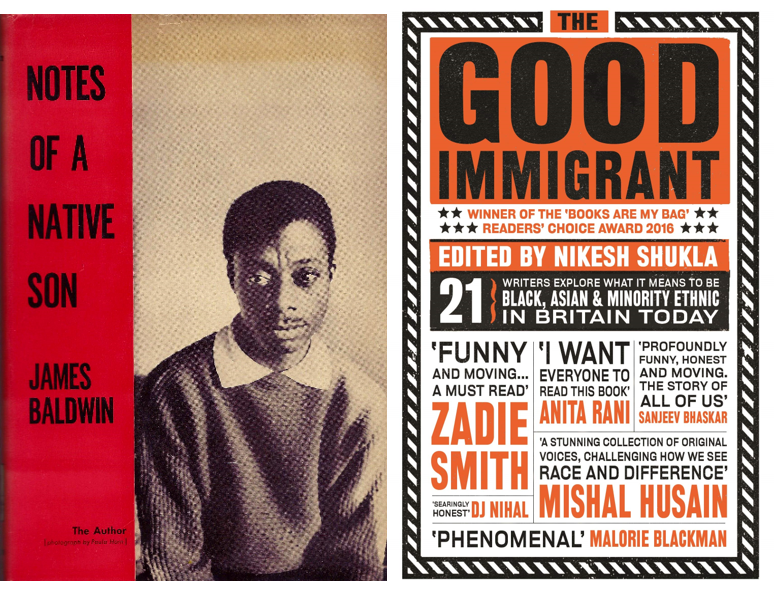
8. Self-Help
Out of all the non-fiction genres out there, this is probably the most popular one. The name itself is explanatory: a self-help book provides you with some guidance and actions through which you can solve personal problems. Self-help books can be research-based, or they can be reflective — like an extended blog post. Note, though, that while the latter kind may read somewhat like a memoir in style, if you choose to write a self-help book, you must explicitly advise the reader.
Q: How can an author balance factual accuracy with narrative style in creative nonfiction?
Suggested answer
Of course, no writer has an objective viewpoint. But the nonfiction writer still must present things as they are without changing the facts. Some methods for making nonfiction compelling include:
- playing with structure, not in terms of cause and effect, but in the storytelling
- exploring the interior world of a character and their emotional landscape
- using vivid and colourful language
It's clear that one cannot simply add new facts or concrete details because it would suit the text. But it is within restrictions where creativity thrives. A way to overcome this is to fuse the subjectivity of the observer with the events or story that is being told. This is more true to experience and the inner world of the subject becomes part of what is reported.
I can think of no better example than Joan Didion's "The White Album." This is an extraordinary essay about California at the end of the sixties. It's factually accurate but intimately personal at the same time. Rather than see the subjectivity of the writer as a hindrance to reporting nonfiction, she immerses herself in it. This essay is a wonderful example of the writer embracing her subjectivity, to see the outer world with it.
Don is available to hire on Reedsy ⏺
While the story must be accurate and true, there are elements of fiction writing that can come into play to bring the story to life and make the narrative truly sing and jump off the page. What do the people in the story look like? What does the setting look like? What can be heard, tasted, touched, or smelled?
For instance, let's say the author is discussing having a cup of coffee with a friend. They might simply say:
I met my friend at a coffee shop to chat.
While the above might be a true statement, there were other things likely happening during that episode. Things to include might be:
- The noise or quiet of the shop
- The aromas wafting through the air
- What was ordered at the counter
So, the above sentence might be beefed up, but still be true, by saying instead:
I met my friend, Jane, at the local coffee shop for a heart-to-heart chat at noon on Saturday. Big mistake. The lines were long, and the place was noisy, crowded, and smelled of burned croissants. We ordered soy lattes and headed to a nearby wooden bench outside since it was spring in Chicago and the weather was breezy, sunny, and mild.
By adding a sense of place and including smells, sights, and sounds, the original sentence can be broadened to create more of a sense of setting and pull the reader into the narrative in a stronger way, while still staying true to what actually happened that day.
Melody is available to hire on Reedsy ⏺
📚 Examples
Outliers by Malcolm Gladwell
What makes a person successful? Gladwell argues that it’s hardly just luck — even prodigies aren’t guaranteed recognition. Pulling from various examples and sociological studies, he identifies several factors, beyond genetics, that anyone can optimize to boost their chances.
The Subtle Art of Not Giving a F*ck by Mark Manson
Sometimes what you need is for someone to give it to you straight. That’s when conversational, hilarious, blog-style books like this become handy. Mark Manson’s self-help book is all about accepting what you’re given and not allowing expectations ruin your happiness.
9. Business and Economics
While this a broad category that may include volumes with a journalistic flavor, business books tend to be guides to entrepreneurship and management. It’s a medium for those who've had experience in the workplace or the market to share their tips and tricks (and also a good tool for authors to bag guest-speaking events). In this sense, this kind of book is like self-help, but specifically for entrepreneurs and business managers.
📚 Examples
Profit First by Mike Michalowicz
Master the art of financial management through real-life case studies and a four-principle system with which can be applied to any business. It's straightfoward and has enough examples to demonstrate its success.
The Big Short by Michael Lewis
Lewis makes the mess of the financial crisis of 2008 that little bit easier to wrap your head around in this darkly humorous book. He follows the stories of ordinary people who fell victim to the American financial sector, revealing the precariousness of this ever-expanding industry.
10. Health and Wellness
There's no shortage of health and wellness books out there — what do we care about if not a long and healthy life, right? These books cover many different topics, from diets to sleeping habits, from stress management to dealing with anxiety. Most are written by researchers and doctors, who have the technical knowhow to offer sound insight and advice.
📚 Examples
Lifespan by David Sinclair
Drawing from his knowledge as a geneticist, Sinclair gives readers the scoop on the ever-popular topic of aging. He assures us that for a long, healthy, and happy life, we should enjoy our chocolate and wine (in moderation, of course).
This Is Your Brain on Food by Uma Naidoo
Food provides more than just nutrients for sustenance and growth — what you eat also impacts your mood and mental health. Dr. Uma Naidoo is a psychiatrist, nutritionist, and a professional chef, so you can trust she knows what she’s talking about.
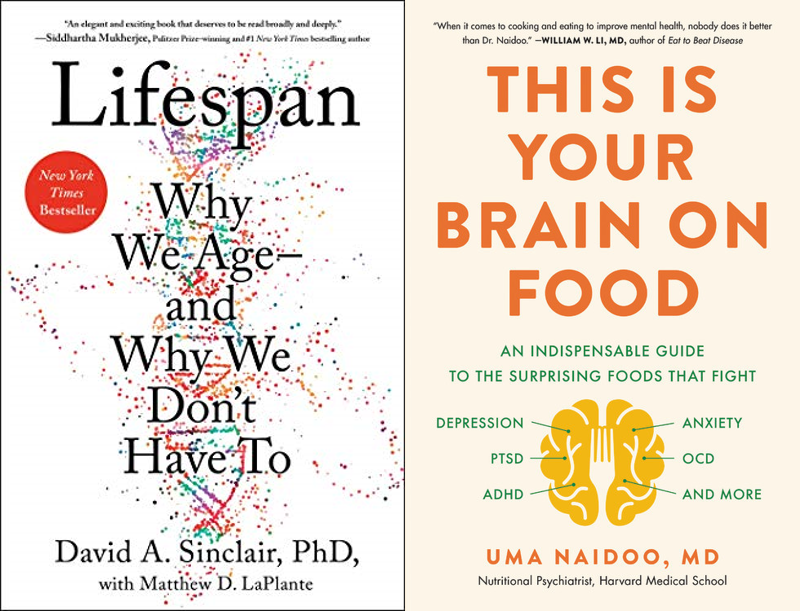
11. Crafts and Hobbies
Once upon a time, before Google became the omniscient engine that held the answer to all our questions, people relied on craft books to teach them how to pick up a new hobby. Origami, crochet, calligraphy, gardening — you name it, there’s a book about it. Nowadays, books like these appeal to the audience not solely because of the skills but also the author. Authors are usually someone with an online presence and authority when it comes to the craft, and their book's tone and interior design usually reflect a bit of their personality.
📚 Examples
By Hand by Nicole Miyuki Santo
Beautifully designed with plenty of samples with which readers could practice their own calligraphy, Santo’s guide is a meditative exercise book. It’s also a great avenue for her followers on Instagram to come closer to her art by practicing it themselves.
Alterknit Stitch by Andrea Rangel
For knitters who have already nailed down the basics and want to experiment with new patterns, this is the book to get. It demonstrates ways to have fun with this cozy hobby by defying the conventions of knitting.
12. Travel Guides
Again, the internet seems to have taken over from books when it comes to helping travelers and tourists discover new places. Still, travel guides are a lot more comprehensive, keeping everything you might need to know about budgeting, languages, places to visit (or avoid), and much more, in one place. Ebooks are the perfect format for these guides — they’re easy for travelers to refer to on the go, and they’re not as costly to update to include the latest information.
📚 Examples
The Lonely Planet series
This collection has been growing since the 1970s, and it now holds plenty of books with various focuses. There are guides solely on helpful phrases in foreign languages, and then there are regional, country-level, and city guides, all made with contributions from locals.
The Time Out series
While also written by locals, these books focus only on cities (mainly in Europe and the US). As with the magazine of the same name, the content of the books is all about local haunts and hidden shops that tourists may not be aware of.
13. Cookbooks
Cookbooks make up another type of nonfiction that’s evermore popular, and not just because we’re cooking more and more at home nowadays. They’re increasingly beautiful, and to write a cookbook is to have a vision in mind about what kind of mouth-watering photos (or illustrations!) it would offer alongside easy-to-follow instructions. They also tend to have cohesive themes, i.e. desserts for vegans, at-home experimental fine-dining, or worldly culinary adventures from your kitchen.
📚 Examples
In Bibi’s Kitchen by Hawa Hassan and Julia Turshen
Grandmothers from eight different Eastern African countries show readers both hearth and heart through the familial stories associated with their food. Beyond the loving taste of traditional homecooked dishes, readers will also get to learn about life in the villages of Africa.
Q: How do you help nonfiction authors organize their ideas for a logical flow in their books?
Suggested answer
This is where it's really helpful to have a detailed table of contents or an outline of all of the chapters and their summaries. Nonfiction still needs to have an overarching cadence and flow, just like the fiction counterparts. It is important to speak to readers where they are and keep them captivated. Captivated means they need to keep reading more, so the ideas need to build upon one another ultimately leading to a satisfying conclusion.
There are lots of ways to do this, but if you're a tactile person like myself, one of the best methods to help with organization is to write down the chapter titles (and maybe a quick sentence description) on post it notes or index cards. Then you can physically move them around and see which combinations work and which ones don't. You might see, for example, that Chapters 4 and 5 absolutely must follow one another, so maybe you tape those two together. But then you can see that there are certain parts of Chapter 6 that actually need to come before chapter 5--and so now Chapter 6 goes before Chapters 4 and 5 (remember, we stuck these two together for a reason!), and suddenly the flow of information feels more seamless.
There are lots of other ways to do this too, you can use Excel or any other spreadsheet if you want to still move things around in a digital way. You can even do the same thing in Word or any word processor by copying and pasting.
Another piece to consider as you start to think about your chapters is the overall message and takeaway from your work. If you've written an introduction or a summary of what the book is going to be and the poignant focal points, then that's your blueprint that you want to refer back to. Create the guide for yourself and as you write the chapter summaries, ask yourself, "What does this chapter add to my book that amplifies or resonates with my overall idea?"
By doing this, you'll create chapters that are meaningful and necessary!
Matt is available to hire on Reedsy ⏺
I provide outline templates if needed. It helps to have this in place before writing, and this is something that can be done while coaching writers. However, these templates can also come in handy even after a book has been written. Sometimes, some chapters may need to be flipped and change places with another chapter. Sometimes a chapter needs to be trimmed or may need to be developed more. Having a solid idea of what the book is about, the goal of the book, and knowing who your target audience is will help refine and define these details.
I can discuss all of this while coaching an author or after editing a book, to help the author see what still needs to be done by answering these questions. I try to read not only as an editor but as a member of the target audience and ask myself, "What do I need or want from the author right now in this chapter? Has the author lived up to the promise made in the title and the introduction of the book? If not, how can I help the author stay on target?"
These are just some of the ways I can assist an author of NF to stay organized.
Melody is available to hire on Reedsy ⏺
I tend to lean toward logic paths and stacked information that leads toward conclusion(s). Contributing bits of new knowledge to a logic structure built of common knowledge allows the author to present their concepts clearly and concisely. Stacked information can be placed along a logic path in a way and at certain points that allow the reader to accumulate reasoning and move toward summations and on to conclusions.
I help the author identify the specific points, transitions, and blocks of contributing information that form the 'bones' of the concept. From that position, the author can construct different logic paths to reach the same necessary conclusions. Each path can be examined and choices made as to which one is the most effective in communicating the concept/idea.
Kinda like a puzzle -- and the author gets to create the pieces.
Maria is available to hire on Reedsy ⏺
Sometimes nonfiction authors forget that their stories have plots. The thinking is that plot is something reserved for fiction, but this couldn't be further from the truth. Narratology, or the study of narrative, holds that the story, the actual sequence of events, is one thing; the plot is how we decide to structure the story.
Each story will contain clues into the right plot structure, be it linear, braided, strategically out of order, or something else. Say the story hold scenes ABCDEFG. We might decide this is the right order for the plot, too; perhaps instead it's EABCDEFG to increase intrigue and address the stakes of the narrative, the climax, right at the beginning, capturing the reader's attention immediately. Some structures make better sense for particular stories, and it is through conversations with authors that we can determine this and then find ways to implement it.
Holly is available to hire on Reedsy ⏺
Ottolenghi Simple by Yotam Ottolenghi
Israeli-English chef Yotam Ottolenghi is the owner of several branches of restaurants, bakeries and food shops in London, but you can get a taste of his cuisine with this collection of 130 Middle Eastern recipes that can be made within 30 minutes. Who says simple cooking couldn't be adventurous?
Midnight Chicken: & Other Recipes Worth Living For by Ella Risbridger
A slightly different take on cookbooks, Midnight Chicken is a manifesto for an joyful life, built on homemade food. Her recipes are simple and homely, just like the illustrations of her book, so that anyone can make them even after a long and tiring day.
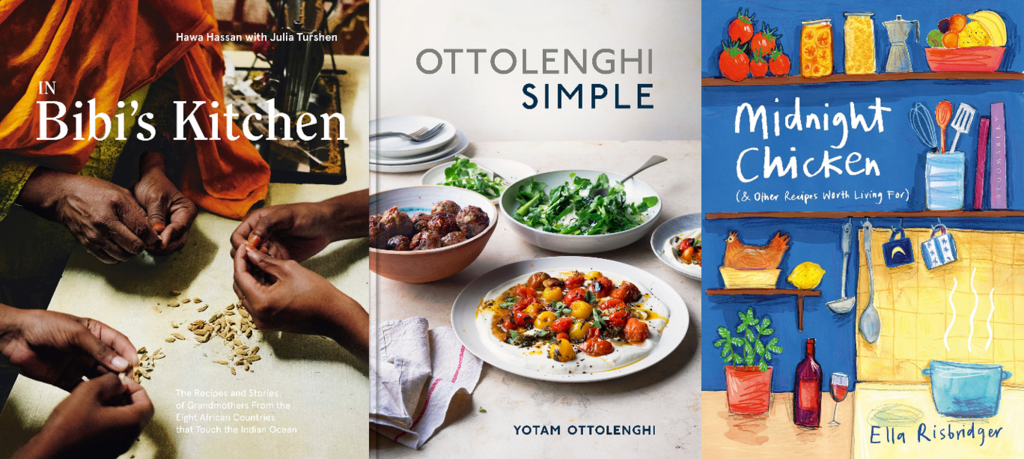
14. Parenting and Family
Parenting is anything but easy, and since Supernanny is not always on air, a little help from experts and those who've had experience dealing with children is the next best thing. From understanding with the psychology of young minds to finding the best environments and ways to nurture them, parenting books with sound academic backing provide useful insights and advice to help readers become better guardians and caregivers.
📚 Examples
Peaceful Parent, Happy Kids by Laura Markham
Based on the latest research on brain development and clinical tests, Markham emphasizes the importance of the emotional connection between parent and child in development. When parents understand their own emotions, they can raise their children with empathy, set healthy boundaries, and communicate with clarity.
Unequal Childhoods by Annette Lareau
Beyond the home, there's a complex world which parents don’t have control of. Annette Lareau sociologically examines the social and political contexts in which children would be exposed to (if they live in America) and how childrearing can be affected by it.
15. Children’s Nonfiction
Explaining the world to children, even on a limited scale, can be incredibly difficult, as it’s hard to keep their attention. Luckily, a bit of assistance from an illustrator can do wonders. As a result, many children’s nonfiction books are in the style of picture books and chapter books. Topics covered include short historical accounts and biographies, or stories that explain scientific phenomena and how they are studied. For a more detailed breakdown of children’s nonfiction, check out editor Melissa Stewart’s system of classification.
📚 Examples
The Little Leaders series by Vashti Harrison
Read about exceptional men and women of various ethnic backgrounds throughout history, and enjoy their adorable portraits in this series. There’s hardly a better way to help children embrace differences than through nonfiction books about diversity such as this.
There Are Bugs Everywhere by Britta Teckentrup
Open young minds up to the natural world through this colorful elementary guide to the insect world. Answering questions about where insects live or how they find and store food with engaging drawings, it’s a great educational tool for parents and teachers.
16. Educational Guides
Many educational guides as the YA version of nonfiction books. These are targeted at final-year high-schoolers and young college students, with the aim providing them some guidance as they reach that strange age where independence is desperately craved but also a bit scary. Unlike popular YA fiction, this is still definitely a niche, yet, as rising study-with-me YouTubers would show you, there is potential for growth. Other than that, there are also learning guides for older audiences as well.
📚 Examples
The Uni-Verse by Jack Edwards
Sharing his experience in preparing for and being at university, Edwards hopes to ensure readers that they, too, could emerge from univeristy happy and successful. From how to take lecture notes to how to get along with your roommates, this guide is full of helpful advice for anyone who’s feeling a bit overwhelmed.
Beginners by Tom Vanderbilt
Education doesn’t have to be limited to the classroom, as Tom Vanderbilt shows us in this call-to-action for life-long learning. As testament to the value of learning as an adult, he tells the stories behind his journey with five skills: playing chess, singing, surfing, drawing, and juggling.
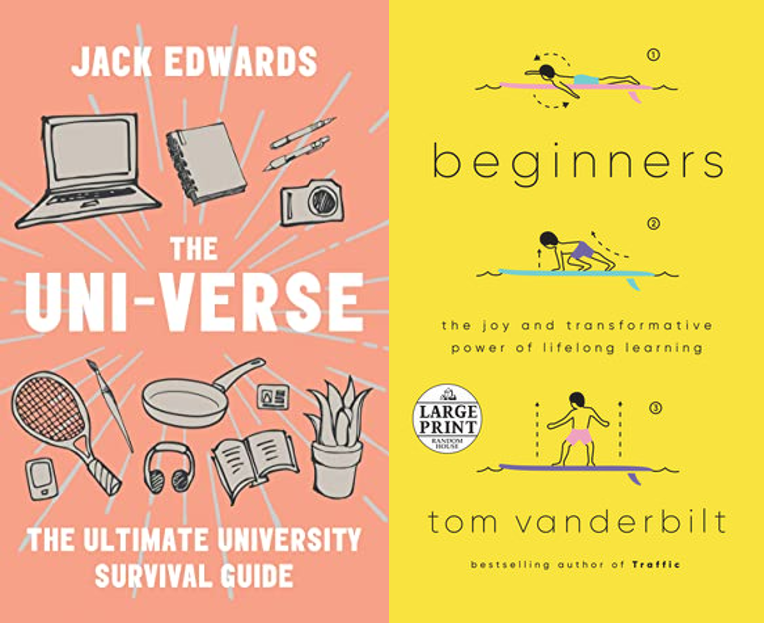
17. Textbooks
We’ve all had our fair share of poring over these books: each comprehensively puts together information about a specific subject (and sometimes even the subject of teaching itself). The content of textbooks also include questions that stimulate learners, encouraging them to reflect on certain matters. As they are meant to accompany a curriculum, textbooks have to be written with a good overarching grasp of the subject and solid understanding of pedagogy. Given all this work, textbook writers deserve more appreciation than they get!
📚 Examples
Oxford’s Very Short Introduction series by Oxford University Press
This popular series offers a short and concise introduction to just about every topic out there. Breaking big concepts and lesson outcomes into bitesize definitions, they make great overviews or quick refreshers before an exam.
Letting Go of Literary Whiteness by Carlin Borsheim-Black and Sophia Tatiana Sarigianides
This textbook is made not for students but for teachers. Based on experiences and examples from their own classrooms, the authors supply advice, and real-life scenarios in which they apply, on how to be anti-racist in schools.
18. Language Books
Language books can be general guides as to how to learn any language, or they can go into the nitty-gritty of a particular language. Some of them aren’t even about learning to use and communicate in a language; instead, they take a dive into the origins and inner workings of these complex systems. Regardless, because of the complexity of the subject, these nonfiction titles require expert knowledge from the part of the author.
📚 Examples
Through the Language Glass by Guy Deutscher
Linguist Guy Deutscher (a perfect name for the profession) makes the case for the connection between language and culture in this volume, opening up a whole new perspective on language learning beyond the practicalities.
How to Speak Any Language Fluently by Alex Rawlings
This book does what it says on the tin: it gives you the tools to pick up any language you want. Rawling's advice is as fun as it is helpful, so everyone can learn their language of choice with extra enjoyment!
19. Humor
Many of them are memoirs of comedians and talk show hosts, others are written by celebrated essayists and journalists. The celebrity profiles of authors in the genre explains humorous nonfiction's popularity. While form may vary, most of these titles are penned as social commentaries that candidly talk about issues that are often overlooked.
📚 Examples
Assassination Vacation by Sarah Vowell
A witty exploration of the legacies of presidential assassinations in America, which notes how they’ve been used for political and commercial purposes that ridiculously undermine their historical importance. It’s history and politics, but with a healthy dose of sharp humor.
Hyperbole and a Half by Allie Brosh
Bill Gates says it’s “funny as hell”, and that’s all the advertising it needs. Taking the unconventional form of meme-worthy comic strips accompanied by texts to provide context, Brosh’s memoir is a candid reflection on both hilarious and bleak moments she's been through.
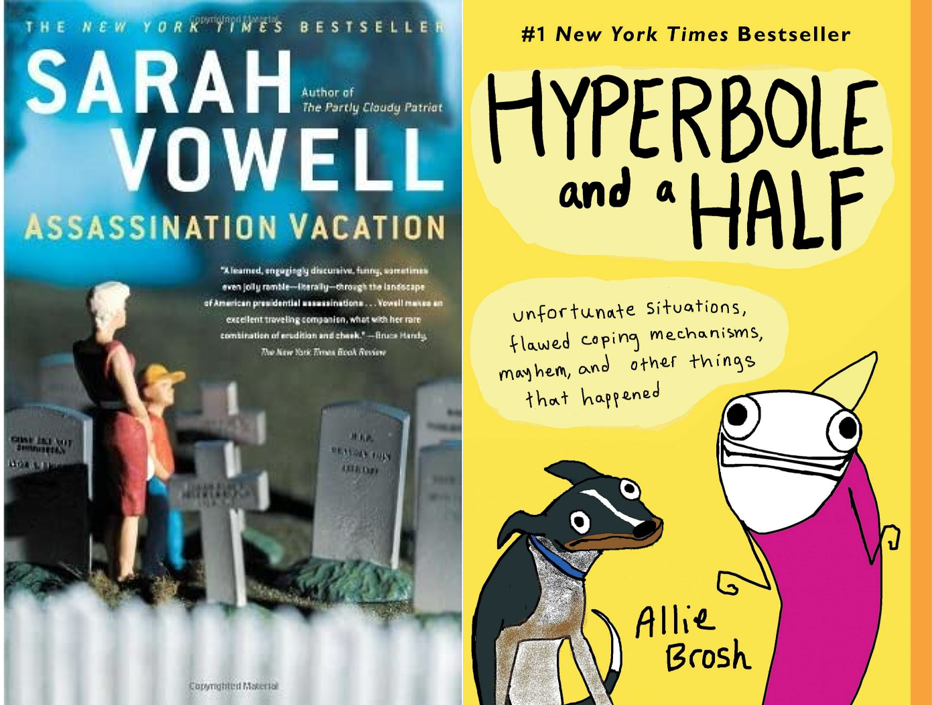
20. Arts Books
The arts section is a fun mix — to name a few, there are photography collections, art catalogues, books on theory and critique, and volumes that teach artistic endeavors. With nuggets of wisdom from industry experts and often great attention paid to design details these books really are like pieces of artwork themselves.
📚 Examples
The World of Art series by Thames & Hudson
This collection offers a variety of art styles and their hallmark pieces from across time and space. You could pick any one of them and feast your eyes on not only the art itself, but the wonderful interior design — courtesy of Adam Hay.
Women Artists by Flavia Frigeri
In a now seminal feminist art history text written in the 70s, Linda Nochlin raised a provocative question: “Why have there been no great women artists?” Well, this addition to the Art Essentials series answers the question by showcasing 50 women artists throughout history, proving that the problem lies not in the lack of female artists, but in the failure to give them the recognition they deserve.
Narrative nonfiction
While narrative nonfiction books are still factual, they're written in the style of a story. As such a book's chapters have a flow — a story structure, if you will — rather than being systematically organized by topic.
21. Memoirs and autobiographies
Memoirs and autobiographies are books about the writer’s life. The former covers a shorter time period, focusing on a particularly noteworthy moment, such as experience in a certain industry, or an unconventional childhood. It’s thus often written by younger authors. The latter follows a longer timeline, going through a whole life, like a personal history. As such, while anyone, with or without a public presence, can put together a memoir, autobiographies are always penned by well-known figures. Autobiographies are also often used by politicians and activists to share their journey and views.
Q: What are some powerful non-celebrity memoirs, and what makes them stand out?
Suggested answer
I love, truly love, A Homemade Life, by Molly Wizenberg. She had an amazing blog for many years, and even won a James Beard Award for it, and this book was her (first) memoir about growing up with food but also her relationship with her parents and her childhood in general. She is an incredibly gifted writer, a genuinely interesting person, and A Homemade Life moved me incredibly.
Jenny is available to hire on Reedsy ⏺
"Sold" by Zana Muhsen. I ghosted this about thirty years ago and people still contact me to say it is their favourite book ever. I think the secret was Zana's incredible honesty and authenticity - plus a powerful plot. "A Boy Called Hyppo" is another powerful story, ghosted for a boy who survived the Rwandan genocide. "The Boy Who Never Gave Up" is the memoir of a refugee from South Sudan who walked, as a boy, to South Africa.
Andrew is available to hire on Reedsy ⏺
📚 Examples
Gone: A Girl, a Violin, a Life Unstrung by Min Kym
Prodigal violinist Min Kym was the youngest pupil at the Purcell School of Music, though her life wasn't a bed of roses. While struggling with the theft of a 17th-century Stradivarius in her possession (which made national headlines in the UK in 2010), she came to realize with incredible clarity that she had lost much more on the journey to meet the expectations of her teachers, her parents, and the world. And all of it was beautifully recorded in this memoir.
A River in Darkness by Masaji Ishikawa
Masaji Ishikawa's life in Japan is just like any ordinary person’s life, but to have gotten there, he’d undergone the challenges of escaping the totalitarian state of North Korea. His experience with this totalitarian state and his subsequent escape makes for a memoir readers can't put down.
Long Walk to Freedom by Nelson Mandela
The man at the heart of one of the biggest, most publicised international movement against racial discrimination and for political freedom shares his journey from being an activist to his 27 years in prison in this autobiography.
22. Biographies
Take note, biographies are different from autobiographies in a very crucial way, even though both are basically life stories. While autobiographies are written by authors about themselves, biographies are written by an author about somebody else. If the subject is alive, their consent should be acquired for ethical purposes (though this isn’t always done). A biography could also be penned long after its subject’s death, presented as a history book that’s focused solely on the life and circumstances of one person. Many of these have gone on to inspire award-winning movies and musicals.
Q: What factors make a biography commercially viable?
Suggested answer
Being famous helps! Failing that, a few factors include a new perspective or approach to the typical life story; great, evocative writing; or experiencing a well-known period or event in history from a personal, original viewpoint. For example, I edited a memoir of a Chinese woman recently who was both a participant in and victim of the Cultural Revolution -- many readers would be interested in that aspect.
John is available to hire on Reedsy ⏺
📚 Examples
Washington: A Life by Ron Chernow
Ron Chernow is truly the master of biographies, and any of his titles would be a great example of his brilliance as a writer and researcher. This Pulitzer Prize winner on America’s founding father is recommended for its nuanced portrait of a legendary figure. Chernow took four years to research and an additional two to complete the manuscript — it was no easy project!
A Beautiful Mind by Sylvia Nasar
Perhaps more famous for its movie adaptation starring Russell Crowe and Jennifer Connelly, Sylvia Nasar’s biography provides a window into the turbulent life of schizophrenic mathematician and economist John Nash. While it challenged ethical practices by not consulting with Nash even though he was alive, the book was still very well-received.
23. Travel Literature
Some call them travelogues, others call them travel memoirs — either way, travel literature books straddle the line between informing on the many cultures of the world and self-reflection. Books that fall into this genre are usually quite poetic and insightful (unlike practical travel guides). They’re all about personal journeys that are meditative and eye-opening, and can be about a specific place or a series of places.
📚 Examples
Full Tilt: Ireland to India with a Bike by Dervla Murphy
In 1963, Dervla Murphy kept a daily diary of her trek “across frozen Europe and through Persia and Afghanistan, over the Himalayas to Pakistan and into India.” After the trip, she published the diary and invited readers to join her on this remarkable feat, whether from their couch or as they start their own journey.
Notes from a Small Island by Bill Bryson
Focusing on the place and not the journey, Bill Bryson documents his “farewell tour” of the UK as he prepared to return to America after almost two decades of living across the pond. Mixing cultural insights with a healthy dose of humor, he wraps his travel notes in social commentary to both satirize and praise the idiosyncrasies of the British.
24. Journalism
Follow investigative journalists as they uncover ugly truths. Other than doing justice by in-depth and sometimes even dangerous investigations, this type of nonfiction also enthralls readers with the twists and turns of real events and details of actual underground operations, conspiracies, and court dramas, to name a few.
📚 Examples
All the President’s Men by Bob Woodward and Carl Bernstein
Journalists Woodward and Bernstein's reports in The Washington Post won them a Pulitzer Prize and led to President Nixon’s impeachment. In this book, they recollect the process behind their famous exposé on Watergate.
Catch and Kill by Ronan Farrow
On his trail to investigate Harvey Weinstein’s alleged sexual assaults, Farrow discovered a systematic mechanism which favors offenders with big pockets and silences the voice of victims. His book is thus an exposé on the journalism industry itself.
Voilà! Those are 24 of the most popular types of nonfiction along with some typical exmaples. And keep in mind that as more and more titles get released, the genres will expand beyond this list. It goes to show how expansive this side of the publishing world can be. If you’re writing, publishing, or marketing a nonfiction book, hopefully this list has clarified the purpose, styles, and formats of each genre so that you can find the perfect fit for your own work.

